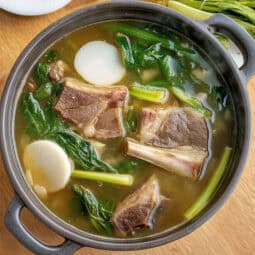
Sinigang na Baka (Filipino Sour Beef Soup)
Sinigang na Baka is a classic Filipino sour soup featuring tender beef short ribs simmered in a clear, tamarind-based broth with crisp vegetables. This hearty dish balances rich, meaty flavors with bright acidity and fresh vegetables like taro, radish, and water spinach, creating a comforting meal that's both nourishing and deeply satisfying. The beef slowly cooks until fork-tender while the broth develops its signature asim-kilig (mouth-puckering sourness) that Filipinos love.
Equipment
- Large heavy-bottom pot (kaldero) or pressure cooker for achieving tender meat
- Sharp knife (kutsilyo) for preparing vegetables
- Wooden spoon (sandok) for gentle stirring without scratching the pot
- Soup ladle (sandok) for serving
- Fine-mesh strainer (salaan) if using fresh tamarind
- Measuring cups and spoons (Panukat) for accurate ingredients measurements
- Cutting board (Sangkalan)
Ingredients
For the Broth Base
- 3 pounds beef short ribs tadyang ng baka
- 10 cups water tubig
- 1 large onion sibuyas, peeled and quartered
- 2 large Roma tomatoes kamatis, quartered
- 1 tablespoon fish sauce patis
- 1½ packages 1.41 ounces each tamarind powder (sampalok) or 15 fresh tamarind pieces
- Salt asin and pepper (paminta) to taste
Vegetables
- 6 pieces taro gabi, peeled and halved
- 2 finger chilies siling pangsigang
- 1 white radish labanos, 6 inches, peeled and bias-cut
- 1 bunch water spinach kangkong, separated into stalks and leaves
- Optional: eggplant talong, okra, long beans (sitaw)
Instructions
- First, place your beef short ribs in a large pot and add enough water to cover the meat. Bring this to a boil over medium-high heat. As it boils, you'll see gray foam rising to the top - remove this with a spoon to get a clear broth.
- When the broth looks clear, add your quartered onions, tomatoes, and fish sauce. Lower the heat to a gentle simmer, cover the pot, and cook for about 1 to 1½ hours. You'll know the meat is ready when it easily pulls away from the bone. Add more water occasionally if needed to keep the meat covered.
- Once the meat is tender, add the peeled and halved taro. Let these cook for about 7 minutes until they start to soften. Add your finger chilies (keep them whole for mild heat or cut them for more spiciness) and the sliced radish. Let these cook for another 5 minutes.
- While waiting, prepare your kangkong by cutting off the tough bottom ends and separating the stalks from the leaves. Now add your sinigang mix powder to the pot and stir until it dissolves completely. Taste the soup and add salt and pepper as needed.
- Add the kangkong stalks first and cook for a minute. Then add the leaves and cook just until they turn bright green and slightly wilted, about another minute. Don't overcook the leaves or they'll become too soft.
- If you're using fresh tamarind instead of powder, prepare it while the meat is cooking. Boil the tamarind in a cup of water until soft, mash it well with a fork, then strain the liquid to remove seeds and pulp. Add this to your soup until it's as sour as you like.
- Turn off the heat as soon as the kangkong leaves are wilted. Serve your sinigang hot in bowls, with steaming white rice on the side. For extra flavor, serve with a small dish of fish sauce with chilies on the side.
- Remember: The key to great sinigang is getting the right balance of sour and savory flavors, and making sure your meat is tender while keeping your vegetables crisp.
Tips from Lola's Kitchen
- Choose beef ribs with good marbling for the richest broth
- Never boil the soup vigorously after adding vegetables
- Add kangkong leaves last to keep them bright green
- For clearer broth, blanch the meat first for 5 minutes, drain, then start fresh
Nutrition
Calories: 608kcalCarbohydrates: 42gProtein: 51gFat: 26gSaturated Fat: 11gPolyunsaturated Fat: 1gMonounsaturated Fat: 11gCholesterol: 147mgSodium: 596mgPotassium: 909mgFiber: 7gSugar: 0.2gVitamin A: 2IUVitamin C: 0.1mgCalcium: 40mgIron: 5mg
Tried this recipe?Let us know how it was!